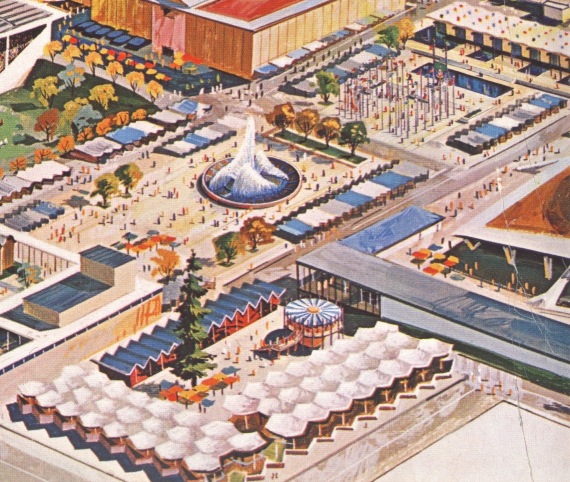THE
WORLD
OF
COMMERCE
AND
INDUSTRY
INTERNATIONAL
AND
STATE
PAVILIONS
INTERNATIONAL AND STATE PAVILIONS
THE WORLDS MIGHTY NATIONS contribute examples on ingenuity and craftsmanship to the World of Commerce and Industry. On the broad International Plaza surrounding the Washington State Coliseum and beyond, on the International Mall, are pavilions of the foreign nations.

The immense universe and the minute atom are parts of the dramatic record of scientific activity in the Pavilion of Great Britain, in the southeastern corner of the International Plaza. The British display achievements in astronomy and in the peaceful uses of atomic power. Their research has provided advancements in food preservation, in the automobile industry and in scientific instruments.
The Republic of China Pavilion, finished in the architecture of an old Chinese palace, presents the changes in the living of the free Chinese. The culture of the island republic is shown in a series of photographs depicting housing, transportation and education. Manufactured products and the work of artisans are displayed.
The aroma of freshly brewed coffee and tea discloses the location of the Brazilian Pavilion on the north concourse of the International Plaza. The Brazilians serve their well-known coffee and a little-known specialty called matte tea. Entertainers and musicians keep things lively. And on the serious side, lecturers and artisans explain the Brazilian culture and industries.
Tremendous changes in social, agricultural and industrial life in the ancient valley of the Nile River are shown in the United Arab Republic Pavilion. Displays show the people, the products and the tourist attractions in Egypt.
The six member nations of the European Economic Communities -- the well-known common market countries -- pool their manpower and resources to tell the story of their efforts and their future.
A quaint Oriental garden is the centerpiece of the Japanese Pavilion. Around it are examples of the arts and the crafts of a mighty industrial nation. The exhibits are a catalog of the changing patterns of life in the island nation.
In the Pavilion of Mexico, craftsmen from all parts of the republic produce their wares of silver, pottery, leather, wool and glass before the eyes of visitors.
The possible development of the Northwest Territories and the Arctic is explained in the Pavilion of Canada. Also on exhibit are Canadian skills in mapping, space exploration and medicine.
The Danish Pavilion is a showcase for Danish handicrafts, furniture and textiles. The imaginative and bold Danish designs are presented as the designs of the future.
Another display of Scandinavian excellence is in the Swedish Pavilion, where visitors may examine delicate crystal and sturdy steel products.
The second complex of foreign commercial and industrial exhibits is on the International Mall, in the northwestern corner of the fair.
The Philippine Pavilion is a gallery of art and architectural artistry. The exhibit is divided in displays of the Land, the People, Commerce and Industry and Life and Culture.
Thailand presents its story with samples of famed Thai silks, raw materials and spices. Movies tell about the country's history, its people and its scenic wonders.
The Association for the United Nations sponsors a lounge and exhibit where visitors from all lands can meet and exchange ideas and greetings.
In the Pavilion of India are huge swatches of Indian-made textiles. They highlight numerous examples of industrial productivity. The changing face of India, its culture and commerce are shown.
Products from Korea are displayed in the Republic of Korea Pavilion. Of special interest are the Korean brass ware and lacquer ware exhibitions.
The dramatic story of the City of Berlin's heroic stand -- and island of freedom in a sea of communism -- is told in the Berlin Pavilion. Visitors hear a special message from Willy Brandt, the mayor of the strife-surrounded city.
The accomplishment of the United States Peace Corps is portrayed for the first time in the Peace Corps Pavilion. San Marino, a tiny republic encompassed by Italy, displays its pottery and its postage stamps in its pavilion. And at an information booth, visitors are introduced to the achievements of the African nations which have gained independence since World War II.
PLAZA OF THE STATES
The Plaza of the States, in the center of the fair, presents a stirring tribute to the fifty states of the Union. Flying from poles erected around the rim of the Plaza are the state flags, arranged in order of each state's admission to the union. At the base of each pole is a plaque bearing the state's seal, motto, significant dates in its history, principal products and points of interest. On a platform at the closed end of the Plaza is a huge font of flame, symbolizing unity of the states, which glows continuously throughout the fair. The American and Washington State flags flank a gold reproduction of the state seal of Washington. At night the Plaza is brilliantly illuminated.
Each State is saluted on special days at the fair. During the ceremonies, visiting governors are welcomed, the states' flags are raised and their plaques are unveiled.
